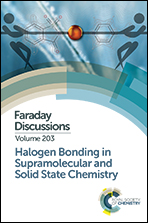Using one halogen bond to change the nature of a second bond in ternary complexes with P⋯Cl and F⋯Cl halogen bonds†
Abstract
Ab initio MP2/aug’-cc-pVTZ calculations have been carried out to determine the effect of the presence of one halogen bond on the nature of the other in ternary complexes H2XP:ClF:ClH and H2XP:ClF:ClF, for X = F, Cl, H, NC, and CN. The P⋯Cl bonds remain chlorine-shared halogen bonds in the ternary complexes H2XP:ClF:ClH, although the degree of chlorine sharing increases relative to the corresponding binary complexes. The F⋯Cl bonds in the ternary complexes remain traditional halogen bonds. The binding energies of the complexes H2XP:ClF:ClH increase relative to the corresponding binary complexes, and nonadditivities of binding energies are synergistic. In contrast, the presence of two halogen bonds in the ternary complexes H2XP:ClF:ClF has a dramatic effect on the nature of these bonds in the four most strongly bound complexes. In these, chlorine transfer occurs across the P⋯Cl halogen bond to produce complexes represented as (H2XP–Cl)+:−(F:ClF). In the ion-pair, the cation is also halogen bonded to the anion by a Cl⋯F− halogen bond, while the anion is stabilized by an −F⋯Cl halogen bond. The central ClF molecule no longer exists as a molecule. The binding energies of the ternary H2XP:ClF:ClF complexes are significantly greater than the binding energies of the H2XP:ClF:ClH complexes, and nonadditivities exhibit large synergistic effects. The Wiberg bond indexes for the complexes H2XP:ClF, H2XP:ClF:ClH, and H2XP:ClF:ClF, and the cations (H2XP–Cl)+ reflect the changes in the P–Cl and Cl–F bonds. Similarly, EOM-CCSD spin–spin coupling constants are also consistent with the changes in these same bonds. In particular, 1xJ(P–Cl) in H2XP:ClF complexes becomes 1J(P–Cl) in the ternary complexes with chlorine-transferred halogen bonds. A plot of these coupling constants shows a change in the curvature of the trendline as chlorine-shared halogen bonds in H2XP:ClF:ClH become chlorine-transferred halogen bonds in H2XP:ClF:ClF. 1xJ(F–Cl) coupling constants also reflect changes in the nature of F⋯Cl halogen bonds.
- This article is part of the themed collection: Halogen Bonding in Supramolecular and Solid State Chemistry


 Please wait while we load your content...
Please wait while we load your content...